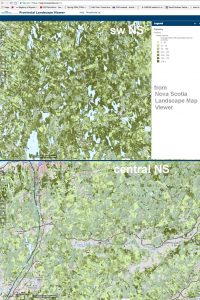A letter in Voice of the People from Helga Guderley reminds us of Nova Scotia’s greatest assets for removing carbon from the atmosphere:
…the best technology for reducing atmospheric CO2 was invented long ago. Trees, grasses, marine and terrestrial plants sequester atmospheric CO2 very effectively using methods perfected over millions of years. All we need to do to use this wonderfully evolved process is to keep or, even better, increase our forest cover.
Perhaps Nova Scotia could outlaw clearcutting and promote selection harvesting. Perhaps Nova Scotia could integrate carbon sequestration by forests into our cap-and-trade market. Perhaps Bill Lahey’s review of forestry practices could integrate the explicit benefits provided by standing, living trees into the decisions about whether and how trees should be harvested. – Helga Guderley Old-fashioned CO2 removal (CH, Dec 8, 2017)
‘Couldn’t agree more. But if we want to “integrate carbon sequestration by forests into our cap-and-trade market”, we better not clearcut those high volume forests that are still around in southwest Nova Scotia. On the other hand, we can cut them selectively and still contribute towards carbon capture and storage and, with the appropriate Cap-and-Trade market in place, gain additional financial benefit:
CFI [Community Forest International] has already been paid slightly more than $300,000 for the carbon stored on our 705-acre woodlot over a 100-year contract. Put another way, we have been paid $3,000 per year for 100 years to keep our average stocking above 20 cords to the acre. We can still cut every tree on that woodlot, just not all at once.” – Dale Prest, NSWOOA Nov 2016
For most of central and eastern Nova Scotia we need to let those vast swaths of clearcut forests regrow and keep growing (taking up carbon dioxide as they do) until they reach volumes of at least 20 cords/acre (approx. 180 cubic meters per hectare), then harvest selectively. That likely means no cap-and-trade benefits until we reach at least 20 cords/acre, a price paid (and not the only one) for past excesses.
The carbon book-keeping tells us we can thin the young forests to increase growth and use the thinnings as we might wish to heat our homes ( not for electricity), but clearcutting our forests for bioenergy will increase our output of carbon dioxide, not reduce it.
It’s not complicated folks but we do need to do the proper accounting. The world is going to demand it.

